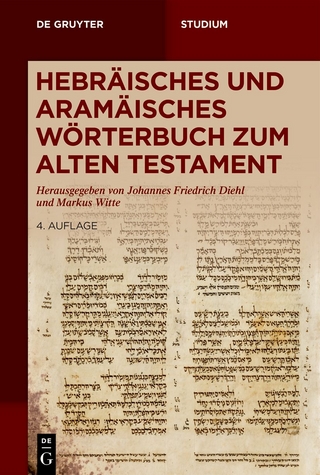
New Testament Semiotics
Brill (Verlag)
978-90-04-46575-6 (ISBN)
Focusing on linguistic signs, New Testament Semiotics navigates through different realist and nominalist traditions. From this perspective, Saussure’s and Peirce’s traditions exhibit similarities. Questioning Derrida’s and Eco’s semiotics based on their misuse of Peirce’s innovations, Dr. Privatdozent Timo Eskola rehabilitates Benveniste and Ricoeur. A sign is about conditions and functions. Sign as a role is a manifestation of participation. Serving as a sign entails participation in a web of relations, participation in a network of meanings, and adoption of a set of rules. We should focus on sentences and networks, not primitive reference or binary oppositions. Enunciations are postulations producing evanescent meanings. Finally, the study suggests a linguistic approach to metatheology that is based on hermeneutics of discursive resistance.
Timo Eskola, Dr.theol. (1992), Dr.phil. (2011), Privatdozent (University of Helsinki). He is the author of Beyond Biblical Theology: Sacralized Culturalism in Heikki Räisänen’s Hermeneutics (Brill, 2013), and A Narrative Theology of the New Testament (WUNT, 2015), among other works.
Preface
Introduction
1 A Short History of the Semantic Triad: On Nomination and Signification
1.1 From Aristotle to Augustine
1.2 The Rise of Nominalism: Abelard
1.3 Moderate Realism: Aquinas and Scotus
1.4 Ockham’s Razor: The Decline of Metaphysics
1.5 Semiotic Approaches: Poinsot, Arnauld, and Locke
1.6 Realism, Nominalism and the Epistemological Triad
1.7 Considering the Semiotic Triad: Some Conclusions
2 Toward a Linguistic Solution: Saussure’s Signifiant and Signifié
2.1 A Distinction between Langue and Parole
2.2 The Aspects of Synchrony and Diachrony
2.3 New Definition of the Linguistic Sign: The Signifier and the Signified
2.4 The System of Signs: Values and Differences
2.5 Sentences: Syntagmatic and Associative Relations
2.6 Sign and System: Is There a Saussurean Triad?
2.7 Against Nominalism: Some Conclusions
3 Understanding Semiosis: The Peircean View
3.1 Whatever “is” Is Representation
3.2 Peirce’s Pure Categories
3.3 Semiosis Reflecting the Semiotic Transformation
3.4 A Classification of Representations: A Basis for the Theory of Signs
3.5 Using Signs: Semiosis, Sign, and Signification
3.6 What Is a Sign: Some Conclusions
4 Peirce and Saussure: Two Ways or a Common Path?
4.1 Symbols (Words) and Peirce’s Modal Categories
4.2 The Linguistic Sign
4.3 Peirce’s Equivalents for signifiant and signifié
4.4 The Process of Semiosis as Sign Translation
4.5 Why Do Symbols Grow?
4.6 Meaning and the Production of Interpretants: Some Conclusions
5 Reading Peirce in Paris: Derrida’s Poststructuralist Semiotics
5.1 The Critique against Logocentricism
5.2 Derrida’s Husserlian Phenomenology
5.3 The Structure of Signification (noema)
5.4 Différance as the Ontological Difference
5.5 Deconstruction as a Means for Dismantling Différance: Some Conclusions
6 Confusing the Triads: Derrida and Eco
6.1 On the Elements of Semiosis
6.2 Noema as Interpretant
6.3 The Problem of Arbitrariness
6.4 Sinsigns without Legisigns
6.5 Differánce as Semiosis
6.6 Appropriation and Inversion: Some Conclusions
7 Linguistic Turns and the Rebirth of Semantics: On Parole/Discourse
7.1 From Langue to Parole: Benveniste on Enunciation
7.2 Jakobson’s Communication Theory: Encoding and Decoding
7.3 The Construction of Meaning in Sentences: Ricoeur
7.4 New Semantics: The Legacy of Nida and Louw
7.5 Discourse and Meaning: Some Conclusions
8 Sign and Semiosis in the New Testament: Metanarratives and Metaphors
8.1 Beyond Sentence: Narrative and Metanarrative
8.2 Narrative in Action: Jubilee and Liberation from Egyptian Slavery in Theological Semiosis
8.3 The Peircean Triad and the Principles of Metaphor
8.4 Royal and Cultic Metaphors in Biblical Texts
8.5 Semiosis, Metanarratives and Interpretants: Some Conclusions
9 A Test Case: How to Interpret Atonement
9.1 Setting the Problem
9.2 The Birth of Christus Victor Theory
9.3 The Change of Narrative: Ritschl and Kantian Epistemology
9.4 A New Paradigm: Aulén on Christus Victor
9.5 Words of Caution: Aulén’s Second Phase
9.6 Christus Victor and Attempts to Solve Problems of Reformed Soteriology
9.7 Covenantal Nomism, Justification Theory and Campbell’s Christus Victor
9.8 Signification Processes behind Atonement Theology: Some Conclusions
10 Metatheology and the Hermeneutics of Discursive Resistance
10.1 On the Decline of Meaning
10.2 Non-Realist Traditions, Deconstruction, and Religious Language
10.3 The Semiosis of Religious Ideas
10.4 Metatheology: On the Inventive Moment
10.5 Metanarratives and Hermeneutics of Utterance
Afterword: New Testament semiotics and the return of meaning
Bibliography
Index of Modern Authors
Index of Subjects
| Erscheinungsdatum | 20.08.2021 |
|---|---|
| Reihe/Serie | Biblical Interpretation Series ; 193 |
| Verlagsort | Leiden |
| Sprache | englisch |
| Maße | 155 x 235 mm |
| Gewicht | 910 g |
| Themenwelt | Religion / Theologie ► Christentum ► Bibelausgaben / Bibelkommentare |
| ISBN-10 | 90-04-46575-8 / 9004465758 |
| ISBN-13 | 978-90-04-46575-6 / 9789004465756 |
| Zustand | Neuware |
| Haben Sie eine Frage zum Produkt? |
aus dem Bereich


